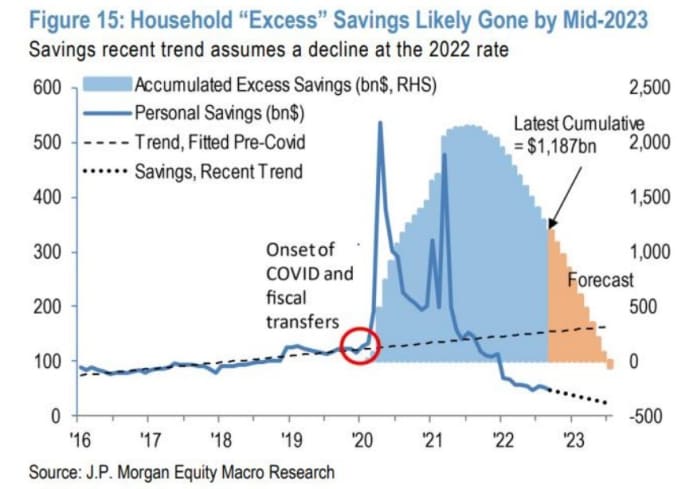Oops. Stocks fell through a key support on Tuesday and it looks like some recent momentum has now petered out. The new line in the sand for the S&P 500
SPX,
seems to be 3,900. Whether Santa eventually comes or not is still to be determined, with Mr. Claus perhaps postponing a decision until next Tuesday’s CPI release.
But what’s clear is that the U.S. stock market is still in a bear market. And with that in mind, equity strategists at BNP Paribas mined 100 years of crashes to try to determine what’s next.
Strategists led by Greg Boutle, head of U.S. equity and derivatives strategy, are expecting a capitulation event next year. “This would be a departure from the current bear market regime, which has been characterized by a grind lower in equities as P/E multiples have contracted,” they say.
The most recent crash — the COVID-19 slump of March 2020 — is a bad template in their view, as it was driven both by the extreme nature of economic shutdowns and rapid monetary and fiscal responses. Nor do they expect 2008 to be the model, as they see U.S. GDP contracting about 1% next year, and earnings per share slipping 1.5%.
However, 2002 is quite representative of recessionary crashes. That bear market was more than two years in length, with a drawdown of 50%, and a 29 percentage point peak-to-trough move in the VIX
VIX,
A typical recession bear market is 1.5 years in length, with a median drawdown of 38% and a median peak in the VIX of 40.5.
“If we apply those averages to the market today, it implies a trough in the middle of next year, the S&P bottoming close to 3,000, and with the VIX in the low 40s,” they say.
The bull market that ended last year was similar to that of the 1990s, with high retail participation, massive P/E multiple price expansion and many of the top performers unprofitable. The S&P 500 troughed in 2002 with a price-to-equity ratio of 14. BNP’s 2024 EPS forecast of $231 implies 3,250 for the S&P 500 if the P-to-E multiple falls to 14.

In a neat bit of analysis, BNP recreated the VIX
VIX,
which CBOE introduced in 1993, to cover the last 100 years. Usually, volatility peaks at or before the market trough.
“We consider a capitulation as a move associated with a sense of panic that involves a rebasing of expectations, analysts aggressively cutting forecasts, volatility spiking and a repricing of tails. Over the last 100 years, the capitulations in volatility have on average come at the same time as the trough in the market,” they say.
What they do like in such a market? One idea is to find companies that have maintained stock buybacks through a slowdown. Another is to look at companies with earnings momentum, though the only sector identified with positive momentum in a related chart is utilities
XLU,
Tech is still vulnerable, though what it calls prime tech could outperform more speculative and cyclical parts of the sector.
The market

After Tuesday’s slump, U.S. stock futures
ES00,
NQ00,
edged lower. Oil futures
CL.1,
fell, and the 10-year yield
TMUBMUSD10Y,
was 3.54%. The inversion between the 2-year and the 10-year is now at levels last seen since the 1980s.
For more market updates plus actionable trade ideas for stocks, options and crypto, subscribe to MarketDiem by Investor’s Business Daily.
The buzz
China on Wednesday announced a series of measures rolling back anti COVID-19 restrictions.
MongoDB
MDB,
jumped 26% in premarket trade after the database company surprised Wall Street with a profit forecast. Ollie’s Bargain Outlet
OLLI,
slumped 9% after missing earnings and revenue estimates. Video game retailer and meme stock GameStop
GME,
reports after the closing bell.
Used car seller Carvana
CVNA,
continued to skid, with Bloomberg reporting that creditors have agreed to team up to avoid conflicts that have arisen in other debt restructurings.
Revised productivity data and October consumer credit highlight a quiet economics calendar.
Raphael Warnock won the runoff to be Georgia’s senator, giving Democrats a 51-to-49 advantage in the upper chamber, allowing them to get judicial nominations through more quickly and issue more subpoenas.
Best of the web
Grindr
GRND,
is the posterchild for imploding SPACs.
More on the commercial property fund exodus in the wake of Blackstone
BX,
suspending redemptions in a key real estate fund.
Police have arrested 25 suspects — including one member of a German noble family — in a plot to overthrow Germany’s government.
Top tickers
Here were the most active stock-market tickers as of 6 a.m. Eastern.
| Ticker | Security name |
| TSLA, | Tesla |
| GME, | GameStop |
| NIO, | Nio |
| AMC, | AMC Entertainment |
| AAPL, | Apple |
| BBBY, | Bed Bath & Beyond |
| COSM, | Cosmos Holdings |
| AMZN, | Amazon.com |
| XPEV, | XPeng |
| BABA, | Alibaba |
The chart

The consumer credit data due later Wednesday may show more evidence of Americans turning to credit cards in the face of rising prices. That build-up in debt comes as savings have deteriorated. Analysts at JPMorgan expect the stimulus payments to have burned off by the middle of next year.
Random reads
What curse words — across multiple languages — have in common.
A picture of a French bulldog helped to smash a drug ring.
This feisty turtle fought off a shark.
Need to Know starts early and is updated until the opening bell, but sign up here to get it delivered once to your email box. The emailed version will be sent out at about 7:30 a.m. Eastern.
Listen to the Best New Ideas in Money podcast with MarketWatch reporter Charles Passy and economist Stephanie Kelton
Source: https://www.marketwatch.com/story/bnp-paribas-studied-100-years-of-market-crashes-heres-what-it-says-is-coming-next-11670412970?siteid=yhoof2&yptr=yahoo
